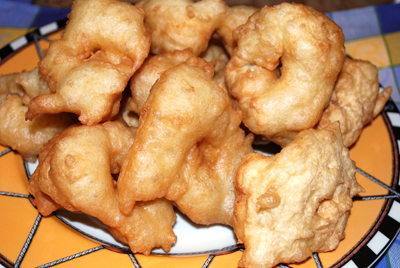
____________________________________________________
By Linda Capeloto Sendowski
 BEVERLY HILLS, California—Hot from the sizzling oil, dripping with warm, lemon scented, honey syrup the bumuelo is a Sephardic tradition. That first bite of sweet crispy goodness is worth the calorie conscious guilt I will feel after eating this traditional goodie.
BEVERLY HILLS, California—Hot from the sizzling oil, dripping with warm, lemon scented, honey syrup the bumuelo is a Sephardic tradition. That first bite of sweet crispy goodness is worth the calorie conscious guilt I will feel after eating this traditional goodie.
Bumuelos also known as birmuelos, as burmuelos, depending on where Sephardic families are from, are the Jewish version of a doughnut or beignet. Since bumuelos originated in Spain, they traveled with Ladino (Judeo Spanish) speaking Jews in the 15th century to the Ottoman Empire as part of their traditional cuisine. Bumuelos have their counterparts in many other countries. This honey puff is known in Greece as loukoumades, and in Syria, as zalabieh.
Where I grew up in Seattle, Washington, we called them bumuelos and my Turkish mother made great ones. She had a special blue enamel pan that she reserved for deep frying French fries or Chanukah bumuelos, and we ate them golden brown, hot out of the oil, after pouring the special syrup on top. My mom or Nona as the kids call her was always the most capable of all her sisters. She is an ace at Sephardic baking including, borekas, baklava, and biscotios and is still going strong at 91. She wears a homemade terrycloth apron with pockets and her tan hands, still nimble, work quickly with the soft sticky dough. Today, I do that job with my mom at our family Chanukah dinner in sunny southern California.
So why do we eat bumuelos or other fried treats on Chanukah? Chanukah commemorates the great, although not long lived, physical victory of the Maccabees over their enemies the Greeks in the year 164 BCE. It is the philosophical victory of freedom of individuality and freedom of religion over the enforced uniformity of the Hellenistic majority.
The Maccabees were a father, his five sons, and all their followers. The most famous was Judah Maccabee or Judah ‘the Hammer’. They conducted a guerilla war from the hills around the town of Modi’in near Jerusalem. The story has it that when the victorious Maccabees returned to reclaim their temple after 3 years of fighting, they found it defiled and used for Pagan rituals. To reinstate the temple, oil was required to rekindle a menorah. The amount of oil available was not sufficient, so a miracle occurred, and the oil lasted for 8 days until they could obtain more.
We recall the miracle of the oil in the victory story by eating fried food. Food as symbolism is used often in the Jewish calendar. Chanukah is not of major religious importance; it’s really just a celebration on the Jewish calendar. However, with the twist of fate of having roughly the same timing as the Christmas holidays Chanukah became huge. We light candles, give gifts or gold coins, and eat.
Most are familiar with latkes made with shredded potatoes, fried in oil, and served with applesauce and or sour cream. I make them all year long, but other kinds of fried treats are consumed as well including, bumuelos, Israeli sufganiyot (filled doughnuts), sweet potato latkes, zucchini ejjeh (fried individual frittatas), and bread crumb crusted cauliflower florets.
This Chanukah, try including bumuelos in your Chanukah feast. It enhances a dinner of latkes and brisket or a dairy meal as well. While I was recipe testing last week I served them for desert after a meal of roast rack of veal with wild mushrooms, braised fennel, Brussels sprouts and baked yams.
Bumuelos
Makes 15-18 bumuelos, serves 6-8, parve
1 envelope rapid rise yeast (2 teaspoons)
1 cup plus 1 tablespoon warm water
1 teaspoon sugar
1 tablespoon vegetable oil
1/4 teaspoon sea salt
2 cups unbleached flour
Vegetable oil for deep frying, (I use about 2 quarts)
Syrup
1 cup water
1 cup sugar
¾ cup honey
1 tablespoon fresh lemon juice
Place the yeast and sugar in a medium bowl. Pour in the warm water and stir. In a few minutes, when the yeast begins to foam, add the oil. Mix the salt into the flour and starting with ½ cup of the flour, whisk it into the yeast and water. Add the flour in additions of ½ cup each and mix until smooth and well blended. The dough will be a little loose and sticky. Cover the bowl with plastic wrap. Set the dough aside in a warm draft free corner to rise for one hour.
Prepare the syrup while you wait for the dough to rise. Place all the ingredients in a saucepan on medium heat. When the sugar has dissolved, let the liquid boil for 5 minutes. Remove it from the heat. (You could make the syrup well ahead and just rewarm it.)
When the dough is ready, preheat the oil in a deep 4-6 quart saucepan pan or deep fat fryer to 360º-365º. The oil should be 3-4 inches deep. Prepare a small bowl with water for wetting your hands. Dough doesn’t stick to wet hands.
With your right hand scoop up about 2 tablespoons of dough into your left hand, make a ball, and open a hole in the center with your thumbs. Then slide the dough off your fingers into the hot oil. The dough will drop into the oil and then unfold into a freeform doughnut with a hole in the center. Fry for about 1.5 minutes on the first side until golden, then flip with a tongs, and fry until the second side is a beautiful gold color. Remove the bumuelo from the oil with a tongs and drain on paper towels. For best results, fry 3-4 at a time so as not to overcrowd the pan.
Dip the bumuelos into the hot syrup and serve. Alternatively, you might pass the syrup and let the guests serve themselves.
*
Linda Capeloto Sendowski is a food blogger and cooking teacher based in Beverly Hills, California. For more recipes, stories, and food, visit her blog at www.theborekadiary.com.
Pingback: Chanukah Bumuelos or Turkish Beignets
one of my favorites! Yum!
Pingback: Chanukah Bumuelos or Turkish Beignets « The Boreka Diary
Hello Linda,
What a pleasure to see a Turkish treat instead of the usual recipe for latkes. I could use more of this kind of Jewish food writing.